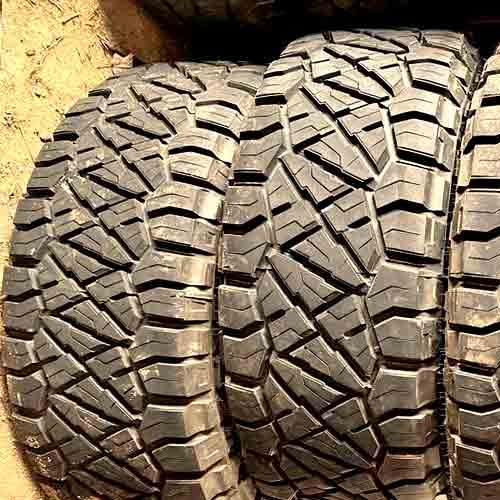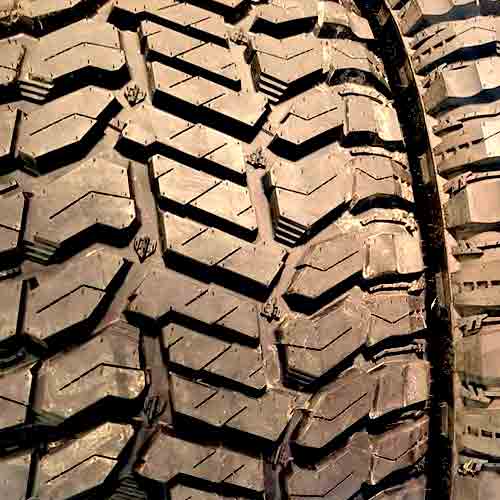Both the Radar Renegade RT and the Nitto Ridge Grappler are hybrid tires, and being in rugged-terrain category, they offer an ideal option for your full sized truck such as Chevy, Ford F-250, Wrangler and Ram. Though still as this tire carry some features over the other, there are a few things to consider here. Let’s find them all out.

In my expert opinion as a tire engineer, the Nitto Ridge Grappler provides superior dry traction, fuel economy and off-road it rocks on rocks. The Radar Renegade RT on the other side, does better with wet and snowy environments on highways, and off-roads, it shines on gravel, dirt, sand as well as muddy terrains.
For Your Info: Renegade R/T is the same as Patriot RT.
Table of Contents
Tire Sizes
On the other side, the Radar Renegade RT comes in 20 to 24 inches with following specs:
- Load ratings available: XL, E and F only
- Speed ratings available: T or Q
- Weight range : 36 lbs to 91 lbs
- Tread depth range: 13/32″ to 20/32″
- LT sizes have 40k miles warranty, whereas non LT have 45k
- Internal construction: 3 ply polyester cover, 2 steel belts and 2 layers of nylon, as cap plies.
The Nitto Ridge Grappler offers 98 total sizes, in 16 to 24 inches, with following specs:
- Load range: SL, XL, and D to F
- Speed ratings: Only T and Q
- Weight range : 36 lbs to 91 lbs
- Tread depth range: 13/32″ to 18/32″ (Most common: 16.4/32″)
- Sizes have no mileage warranty or 3PMSFR (only M+S is seen)
- Internal construction: Same as the Renegade R/T.
Review Nitto Ridge Grappler here: https://tiredriver.com/nitto-ridge-grappler-review/
Tread Structure
Let’s start things form Nitto Ridge first.

So this tire has a tread structured with 4 triangular ribs in the middle. Two of these have notches, while other two (arranged vertically) are seen with other features such as rectilinear sipes, offsets and of-course sharp sides.
And where these (biters) account for off-road traction, the reinforced foundational supports underneath these blocks still provide decent rubber to road contact, enhancing stability on highways (so, it’s kind of a win win).
Together these lugs create Z/X shaped grooves which connect the outer zigzag longitudinal channels, allowing tread to efficiently self clean itself properly, where needed.
Moving towards the shoulders, the tire features less overall biters here, as lugs don’t carry any kind of notches but only mere siping. Though on the outer edges they get to have staggered sides with concave shaped engravings, acting as scoops.
Moreover, the tire also features dual sidewalls, with bulkier lugs (on each side), compared to its counterpart.
Moving on towards the Renegade RT, you get a slightly more aggressive tread design, even though it’s also a hybrid.

Let me start off form the middle, where there’s only a single rib.
This rib contains blocks running a group of 3s (where the central lug, in them, gets wrapped with surrounding two).
This creates an interlocking design enhancing overall on-road directional grip (as central area has the most connectivity with the road). And with reinforced foundations underneath these blocks, you also get stability with these lugs as well.
Moreover, they make lateral grooves, which connect out with the wide outer circumferential channels.
Moving towards shoulders, here lugs although seem to have been divided (longitudinally), they are not (they are still joined up from underneath).
Facing the inner blocks, these elongated shoulder lugs make stepped biters/stairs (some also call them ramps), and along with it off-set edges and towards “outer” sides, they have mud scoops with their staggered patterns.
Furthermore, they also make thick enough sidewall lugs, with dual designs, just like the Nitto Ridge, so you can chose which side to show outwards (on the rim).
Dry Traction
There are two main parts of dry traction, grip, and steering response.
The grip depends on the tire’s footprint, the larger it meets with the road, the better. And so the Nitto Ridge Grappler is able to yield shorter stopping distances and handling times with it’s more closed up tread structure.
It’s compacted triangular blocks in the middle provide ample directional traction, while the packed up shoulders meet with the ground, during cornering, in a better way.
Furthermore, all it’s lugs have reinforced foundations underneath, and although the tire weighs the same as the Renegade R/T, it’s tread depth is smaller. Both of these factors keep the rubber to road connection more stable, as lugs don’t want to flex too much, adding to the tire’s steering response.
Though, keep in mind that the difference between the two tires is only marginal, that’s why they both gives speed ratings up to T.
Wet Traction
Wet traction is where both of these tires lack the most. They although grant ample hydroplaning resistance (with their wider grooves, channeling the water out, avoiding flotation), they lack severely with their limited siping.
Though out of both tires, the Radar Renegade RT still provides somewhat better efficacy, with it’s pulpy tread composition. Let me explain how.
Basically sipes work at a micro level, they capture water particles in their slits by creating a suction (with molding). And so with less silica density, the Nitto Ridge Grappler does not provide ample flexibility to its siping, limiting wet traction.
Fuel Efficiency
Although both tires have similar structural weight, the Radar Renegade RT still consumes more fuel mainly because of it’s softer compound, and a greater tread depth (reaching up to 20/32″).
These factors make lugs more wobbly, and upon acceleration, braking and cornering, they get to be bendy, wasting energy, that could have used in to the movement of the tire as a whole, instead.
Nitto Ridge Grappler with solid reinforced foundations, on the other hand, would not exhibit similar results, and so you get a better fuel economy here.
Do All-Terrain Tires Get Worse Gas Mileage? : https://tiredriver.com/do-all-terrain-tires-get-worse-gas-mileage/
Tread Mileage
In the above section, I explained why the Nitto Ridge Grappler provides better rolling resistance, and with it the fuel efficiency, though it does not mean its tread wear is slower in comparison.
Radar Renegade RT comes with a next gen rubber compound, which is although softer, but also elastic, meaning it would burn slower.
Moreover, the tire’s greater tread depth also helps here, as Renegade takes longer to wear down to 2/32″.
Nitto Ridge Grappler on the other side, is although not too far off with its harder compound, it’s smaller tread depth still lowers it’s life time.
That’s why the tire doesn’t come with any warranty whereas the Radar R/T gives you 45K miles.
Winter Traction
For winter performance, you need two things on a (off-road) tire, snow grabbing abilities, and paddling. And both of these are provided better on Radar Renegade RT, comparatively.
This is because the tire provides much better elongated shoulder lugs paddling it’s way out on deeper fluffy terrains, and it’s stepped edges on these lugs, and the closed up blocks in the middle, surrounded with arrow shaped biters on (the base of) circumferential grooves, allocate it’s tread with superior snow grabbing capabilities.
Nitto Ridge Grappler on the other side, has a lot of biters though, but it’s tread does not provide as much effective snow to snow contact as its counterpart. So I am rating this tire below here, even though both tires aren’t so great overall, and don’t offer 3 peak mountain snowflakes ratings.
For Your Info: Tires with 3PMSF ratings, do 10% better than all season tires, in terms of acceleration performance.
Are A/T tires good in Snow: https://tiredriver.com/are-all-terrain-tires-good-in-snow/
Off Road Traction
I studied both of these tires in following rugged paths, let’s check them out.
Mud Performance
Mud is although pretty challenging terrains for all-terrain tires, with these tires, I am discussing here, that’s not really the case, as they both come in rugged terrain category, having “wide enough” tread voids.
Though mud evacuation is not the only factors here, there’s also paddling ,which puts Radar Renegade RT in a better position here. Let me explain.
The tire for one, has wider grooves in comparison, with better combination of lateral and longitudinal voids, so it lets mud out much easily. And two, it’s shoulder lugs are elongated, which have thicker mud scoops in them, so the tire provides better needed paddling.
Nitto Ridge Grappler on the other side, is although lacking by a hair, it’s narrower grooves, still can’t deliver the same level of traction. Though it’s dual sidewalls (just like those seen on it’s competitor here), provide a decent job in scooping the mud out and backwards, generating forward motion.
Rock Traction
The best tire for rocky terrain must have a soft, flexible tread with lugs that can bend for multiple-angled gripping. The tire must also have strong sidewalls to defend against sharp rocks and punctures, ensuring maximum stability and protection on the road.
Radar Renegade RT is a pretty biting tire, but it lacks in lateral traction, comparatively. I mean don’t get me wrong, it sticks to the ground like a leech, when it comes to climbing directionally, with less aggressive sides in comparison, it’s sideways traction can use some help.
That’s why I am going to go with Nitto Ridge Grappler on this one. This tire although also features dual sidewalls, its lugs are thicker in comparison, and they produce better footprint combined with enhanced climbing abilities with lowered air pressure.
My Guide on Air Pressure on all terrains: https://tiredriver.com/air-pressure-guide-for-all-terrain-tires/
On Sand
For maximum performance on sand, reduce the tire’s air pressure to create a “floating” effect and choose a tire with a soft tread pattern and lightweight build. This is because sinking on this soft terrain is the worse enemy of traction.
And that’s why I am rating Radar Renegade RT a better tire here. The tire has a softer tread for one, has smoother outer edges, and it’s laterally orientated lugs provide paddling (which puts the tire in more control, as it move forward with scooping the sand backwards, without digging).
The Nitto Ridge Grappler has similar weight range (across all sizes), but it’s sharper sides make it more susceptible to sinking, so overall it’s lacking back slightly.
On Gravel and Dirt
When driving on gravely roads, it is necessary to have off-road tires with self-cleaning grooves. That’s why with slightly wider grooves and dual stone ejectors, the Radar Renegade RT provides better efficacy.
(Besides conventional stone ejectors, the tire also places arrow shaped ones on the outer circumferential channels), both of these provide ample evacuation of sharp dirt particles, that could have damaged the tread and caused traction issues.
Nitto Ridge Grappler on the other side, is also not too far back here, as it’s Z shaped tread voids, and ejectors on sides provide ample traction, though its still less compared to Renegade.
To Close Up
Radar Renegade RT although is a pretty aggressive tire, it provides amazing wet and snow performance as well as amazing tread life.
On the other side, the Nitto Ridge Grappler provides superior fuel economy, dry traction (with much better steering response), and amazing off-road traction on rocks.